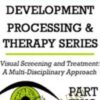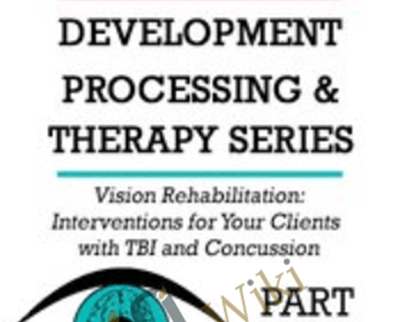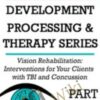$59.99 Original price was: $59.99.$22.00Current price is: $22.00.
1 Hour 13 Minutes
If you are seeing patients with brain injury, vision should be a part of the rehabilitation. The majority of the hardwiring of the brain involves the visual pathway, so it is very common to experience a visual problem after a brain injury or concussion. In fact, over 50% of patients with neurological impairments exhibit visual and visual-cognitive disorders. This number is near 90% for those who are recovering from a concussion.
 Purchase this course you will earn 22 Points worth of $2.20
Purchase this course you will earn 22 Points worth of $2.20Elevate your skills with the Vision Rehabilitation: Interventions for Your Clients with TBI and Concussion – Christine Winter-Rundell course, available for just $59.99 Original price was: $59.99.$22.00Current price is: $22.00. on Utralist.com! Browse our curated selection of over 60,000 downloadable digital courses across diverse Uncategorized. Benefit from expert-led, self-paced instruction and save over 80%. Start learning smarter today!
If you are seeing patients with brain injury, vision should be a part of the rehabilitation. The majority of the hardwiring of the brain involves the visual pathway, so it is very common to experience a visual problem after a brain injury or concussion. In fact, over 50% of patients with neurological impairments exhibit visual and visual-cognitive disorders. This number is near 90% for those who are recovering from a concussion. If visual deficits do exist, they can result in significant difficulty with reading, mobility, and balance, which can prevent your clients from returning to their baseline level of function and independence. Fortunately, neuroplasticity of the visual system exists, and after learning about basic neuro-anatomy, you will be able to accommodate the needs of these patients more effectively.
OUTLINE
Neuro-Anatomy Review
- Magnocellular versus Parvocellular
- Right brain versus Left brain
Visual Sequelae After Brain Injury
- Lobe-by-lobe visual function
- Unilateral Spatial Inattention (Neglect)
- Testing methods
Neuroplasticity of the Visual System
- Is there a critical period for visual development?
- Sue Barry, Fixing My Gaze, and vision therapy
- Brain injury and concussion
Concussions
- Post-Concussional Syndrome
- Pre-Concussion Baseline Screening
Therapeutic Activities: Demonstrations
- Relearning basic eye tracking; saccades and pursuits
- Eye teaming and convergence; the brock string
- Visual processing games and activities
OBJECTIVES
- Discuss basic neuro-anatomy as it relates to visual function.
- Demonstrate screening techniques and therapeutic activities specific to brain injury.
Tag: Vision Rehabilitation: Interventions for Your Clients with TBI and Concussion – Christine Winter-Rundell Review. Vision Rehabilitation: Interventions for Your Clients with TBI and Concussion – Christine Winter-Rundell download. Vision Rehabilitation: Interventions for Your Clients with TBI and Concussion – Christine Winter-Rundell discount.
Cultivate continuous growth with the Vision Rehabilitation: Interventions for Your Clients with TBI and Concussion – Christine Winter-Rundell course at Utralist.com! Unlock lifetime access to premium digital content, meticulously designed for both career advancement and personal enrichment.
- Lifetime Access: Enjoy limitless access to your purchased courses.
- Exceptional Value: Benefit from savings up to 80% on high-quality courses.
- Secure Transactions: Your payments are always safe and protected.
- Practical Application: Gain real-world skills applicable to your goals.
- Instant Accessibility: Begin your learning journey immediately after buying.
- Device Compatible: Access your courses seamlessly on any device.
Transform your potential with Utralist.com!
Related products
Uncategorized
= 85 Points
= 125 Points
Uncategorized
Managing Patient Emergencies: Critical Care Skills Every Nurse Must Know – Dr. Paul Langlois
= 85 Points
Uncategorized
= 85 Points
Uncategorized
= 35 Points
= 84 Points
Uncategorized
= 95 Points
= 65 Points





